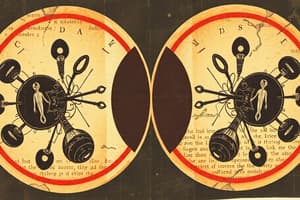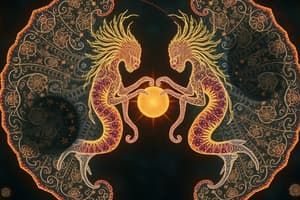Podcast
Questions and Answers
Which of the following characteristics is associated with prokaryotic cells?
Which of the following characteristics is associated with prokaryotic cells?
- Presence of multiple linear DNA molecules
- Absence of a membrane-bound nucleus (correct)
- Large cell diameter ranging from 10 to 100 μm
- Complexed DNA with histone proteins
Viruses contain their own genetic information and are capable of replicating independently within a host cell.
Viruses contain their own genetic information and are capable of replicating independently within a host cell.
True (A)
What is the primary function of histone proteins in eukaryotic cells?
What is the primary function of histone proteins in eukaryotic cells?
packaging dna
The process by which prokaryotic cells divide, resulting in two identical daughter cells, is called ______.
The process by which prokaryotic cells divide, resulting in two identical daughter cells, is called ______.
Match the following phases of the cell cycle with their key events:
Match the following phases of the cell cycle with their key events:
During which phase of mitosis do sister chromatids separate and move toward opposite poles of the cell?
During which phase of mitosis do sister chromatids separate and move toward opposite poles of the cell?
In telophase, the nuclear membrane breaks down, allowing the spindle microtubules to attach to the chromosomes.
In telophase, the nuclear membrane breaks down, allowing the spindle microtubules to attach to the chromosomes.
How many chromosomes would be present in a human cell after mitosis if the original cell had 46 chromosomes?
How many chromosomes would be present in a human cell after mitosis if the original cell had 46 chromosomes?
During metaphase, all chromosomes line up on the ______.
During metaphase, all chromosomes line up on the ______.
What is the main outcome of meiosis?
What is the main outcome of meiosis?
Meiosis I results in the separation of sister chromatids, while Meiosis II separates homologous chromosomes.
Meiosis I results in the separation of sister chromatids, while Meiosis II separates homologous chromosomes.
What is the significance of 'crossing over' in meiosis?
What is the significance of 'crossing over' in meiosis?
The process that halves the chromosome number during meiosis is called a ______ in chromosome number.
The process that halves the chromosome number during meiosis is called a ______ in chromosome number.
Match the following structures with their descriptions regarding chromosome anatomy:
Match the following structures with their descriptions regarding chromosome anatomy:
According to Boveri and Sutton (1902), what explains Mendelian inheritance?
According to Boveri and Sutton (1902), what explains Mendelian inheritance?
Homologous chomosomes are identical copies of each other within a cell.
Homologous chomosomes are identical copies of each other within a cell.
What is a karyotype?
What is a karyotype?
Chromosomes are composed of a single long strand of ______.
Chromosomes are composed of a single long strand of ______.
What is the state of chromosomes during interphase?
What is the state of chromosomes during interphase?
Mitosis results in daughter cells with half the number of chromosomes as the parent cell.
Mitosis results in daughter cells with half the number of chromosomes as the parent cell.
What is the role of the cytoskeleton during mitosis and meiosis?
What is the role of the cytoskeleton during mitosis and meiosis?
A cell with two sets of chromosomes is referred to as ______.
A cell with two sets of chromosomes is referred to as ______.
Match the description with whether it occurs in mitosis, meiosis, or both.
Match the description with whether it occurs in mitosis, meiosis, or both.
How does Giemsa stain help in visualizing chromosomes?
How does Giemsa stain help in visualizing chromosomes?
Telomeres shorten with each cell division, which is associated with aging.
Telomeres shorten with each cell division, which is associated with aging.
Flashcards
Prokaryotic Cells
Prokaryotic Cells
Prokaryotes lack a nucleus, making DNA access easier. They have fewer histone protein complexes.
Eukaryotic Cells
Eukaryotic Cells
Eukaryotes have a nucleus and other structures, histone proteins, and typically more genes.
Binary Fission
Binary Fission
A process where prokaryotes replicate by duplicating their circular chromosome and dividing the cell.
Interphase
Interphase
Signup and view all the flashcards
M Phase
M Phase
Signup and view all the flashcards
Prophase
Prophase
Signup and view all the flashcards
Prometaphase
Prometaphase
Signup and view all the flashcards
Metaphase
Metaphase
Signup and view all the flashcards
Anaphase
Anaphase
Signup and view all the flashcards
Telophase
Telophase
Signup and view all the flashcards
Meiosis Function
Meiosis Function
Signup and view all the flashcards
Crossing Over
Crossing Over
Signup and view all the flashcards
Meiosis Result
Meiosis Result
Signup and view all the flashcards
Boveri and Sutton's Theory
Boveri and Sutton's Theory
Signup and view all the flashcards
Chromosome Pairs
Chromosome Pairs
Signup and view all the flashcards
Mitosis Outcome
Mitosis Outcome
Signup and view all the flashcards
Meiosis Outcome
Meiosis Outcome
Signup and view all the flashcards
Meiosis I
Meiosis I
Signup and view all the flashcards
Meiosis II
Meiosis II
Signup and view all the flashcards
Chromatid Conversion
Chromatid Conversion
Signup and view all the flashcards
Chromatin
Chromatin
Signup and view all the flashcards
Centromere
Centromere
Signup and view all the flashcards
Telomeres
Telomeres
Signup and view all the flashcards
Karyotype
Karyotype
Signup and view all the flashcards
Chromosome Composition
Chromosome Composition
Signup and view all the flashcards
Study Notes
- The lecture covers Mitosis, Meiosis, and Chromosomal Anatomy
- The presentation date is January 27, 2025
Cell Genetic Information Packaging
- Prokaryotes lack a nucleus
- Prokaryotes are easier to read and copy DNA, and have either fewer or no complexes with histone proteins
- Eukaryotes have a nucleus along with other structures, histone, and other associated proteins
- Eukaryotes typically have more genes
Binary Fission
- Binary fission is a simpler process in prokaryotes
Eukaryotic Cell Division
- Eukaryotic cell division is a more complex process
- Mitosis and cytokinesis (cell division) transpire in the M phase
- After the G2/M checkpoint, cells can divide
- In G2, the cell gears up for mitosis
- In S, DNA duplicates
- Interphase is for cell growth
- During G1, cells grow
- Cells may enter G0 which is a non-dividing phase
- After the G1/S checkpoint, the cell is committed to dividing
Mitosis Basics
- Most cells are in interphase except those cells that need to continuously divide
- Prophase dissolves the nuclear envelope, and the spindle develops to pull newly condensing chromosomes
- Prometaphase sees microtubules latch onto chromosomes
- Metaphase aligns all chromosomes on the metaphase plate
- During anaphase, sister chromatids are pulled apart at the centromere
- Telophase occurs when chromosomes arrive in each newly separating cell, new nuclei develop, and cytokinesis takes place
Chromosome Count
- During mitosis, the number of chromosomes remains constant at 4, except during anaphase when it doubles to 8 before cytokinesis
- The number of DNA molecules doubles from 4 to 8 during the S phase and remains at 8 until telophase and cytokinesis, when it returns to 4
Meiosis
- Meiosis I and Meiosis II are the two major stages
- Interphase involves centrosome and chromosome duplication
- DNA is copied
- Prophase I sees chromosomes pairing up, where recombination occurs at the meiotic spindle
- During Metaphase I, chromosomes align at the equator
- Anaphase I sees paired chromosomes pulled apart
- During Telophase I and cytokinesis, the cell pinches in the middle, forming two daughter cells
- Prophase II generates two daughter cells
- Metaphase II sees chromosomes aligning at the equator
- During Anaphase II, sister chromatids are pulled apart
- Telophase II and cytokinesis involves the cell pinching to produce four granddaughter cells
- n = haploid, 2n = diploid
Meiosis - Chromosome Number Reduction
- Meiosis halves the chromosome count during cell division
- If a parent cell contains four chromosomes, the granddaughter cells will have two
Genetic Diversity
- During Prophase I segments of nonsister chromatids are exchanged
- After Meiosis I and II, each of the resulting cells carries a unique combination of alleles
Chromosome Anatomy
- Chromosome behavior during meiosis explains Mendelian inheritance
- Chromosomes come in homologous pairs
- Chromosome pairs separate at meiosis so that each gamete gets one copy
Chromosome Packages
- Mitosis involves both parent and daughter cells that are 2N (diploid)
- Replicated chromosomes divide into daughter cells
- Mitosis happens over a single cell division
- Meiosis involves making gametes over two cell divisions
- Gametes are N (haploid)
- During Meiosis I, homologous chromosomes line up and recombine, dividing into haploid daughter cells
- During Meiosis II, recombinant chromatids are pulled into each daughter cell
- Progenitor cells measure 2N (diploid)
Chromosome Anatomy in Detail
- Chromatids consist of a single long strand of DNA
- Chromosomes start as one chromatid, then get copied into two sister chromatids and pulled apart into two daughter chromatids
- Chromatin denotes a general term for the DNA and the proteins that make up chromosomes
- Every chromosome has a centromere
- The cytoskeleton attaches to the centromere to pull chromatids apart in mitosis and meiosis
- Chromosomes can be categorized based on their centromere position (metacentric, submetacentric, acrocentric)
- Telomeres are at the end of each arm of a chromosome
- Karyotypes represent an individual's set of chromosomes, recognizable as pairs when a cell is divided during mitosis
- Giemsa stain visualizes chromosomes, targeting the phosphate backbone of DNA and reveals bands of GC-rich and AT-rich regions
- Chromosomes are single molecules of DNA packaged into proteins
- During mitosis and meiosis, chromosomes condense into tight packages
- During interphase chromosomes are diffuse, though DNA continues to remain organized around proteins
Studying That Suits You
Use AI to generate personalized quizzes and flashcards to suit your learning preferences.
Related Documents
Description
Lecture on Mitosis, Meiosis, and Chromosomal Anatomy. Includes cell genetic information packaging and eukaryotic cell division. Covers the differences between prokaryotes and eukaryotes, binary fission, and the basics of mitosis.





